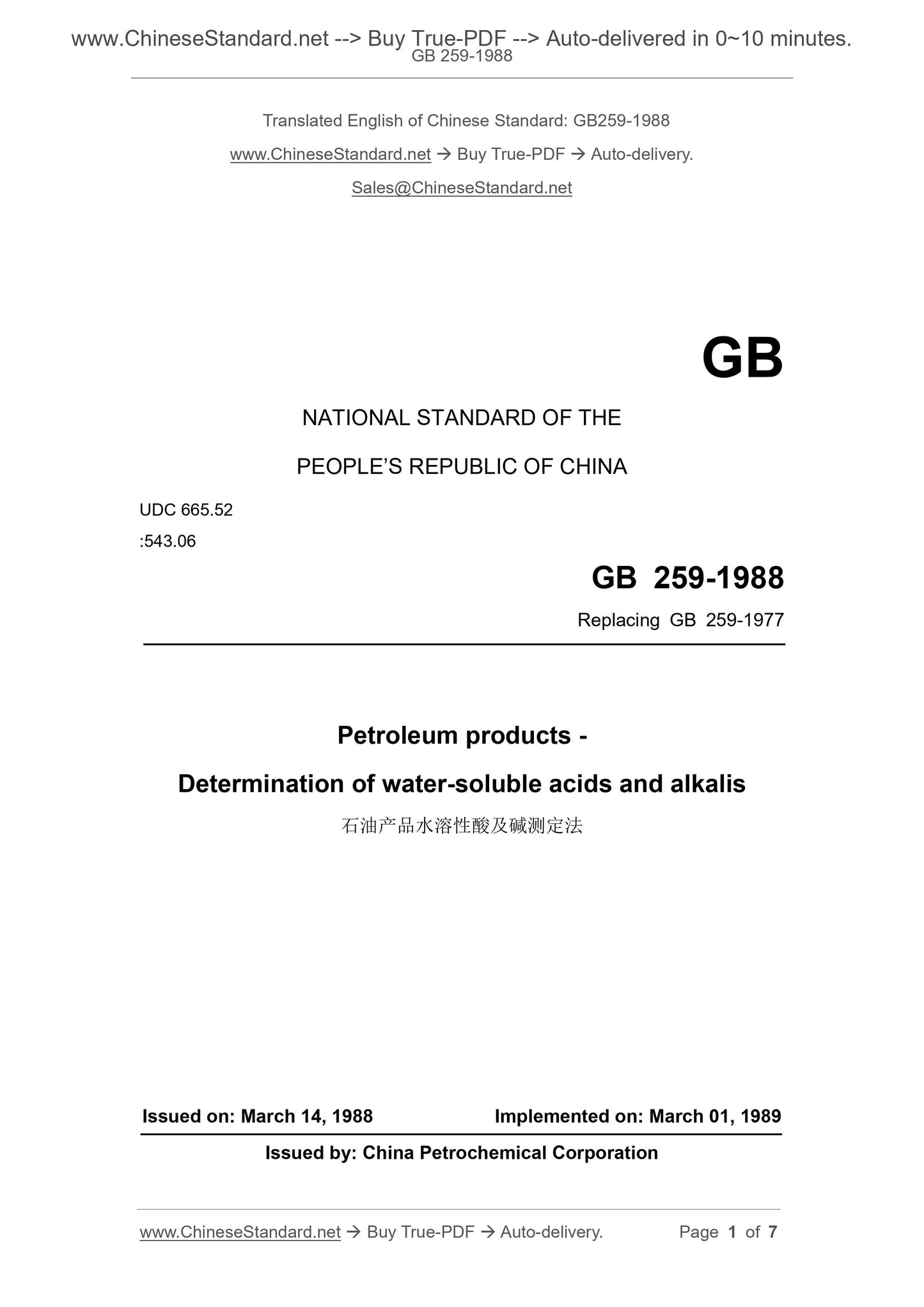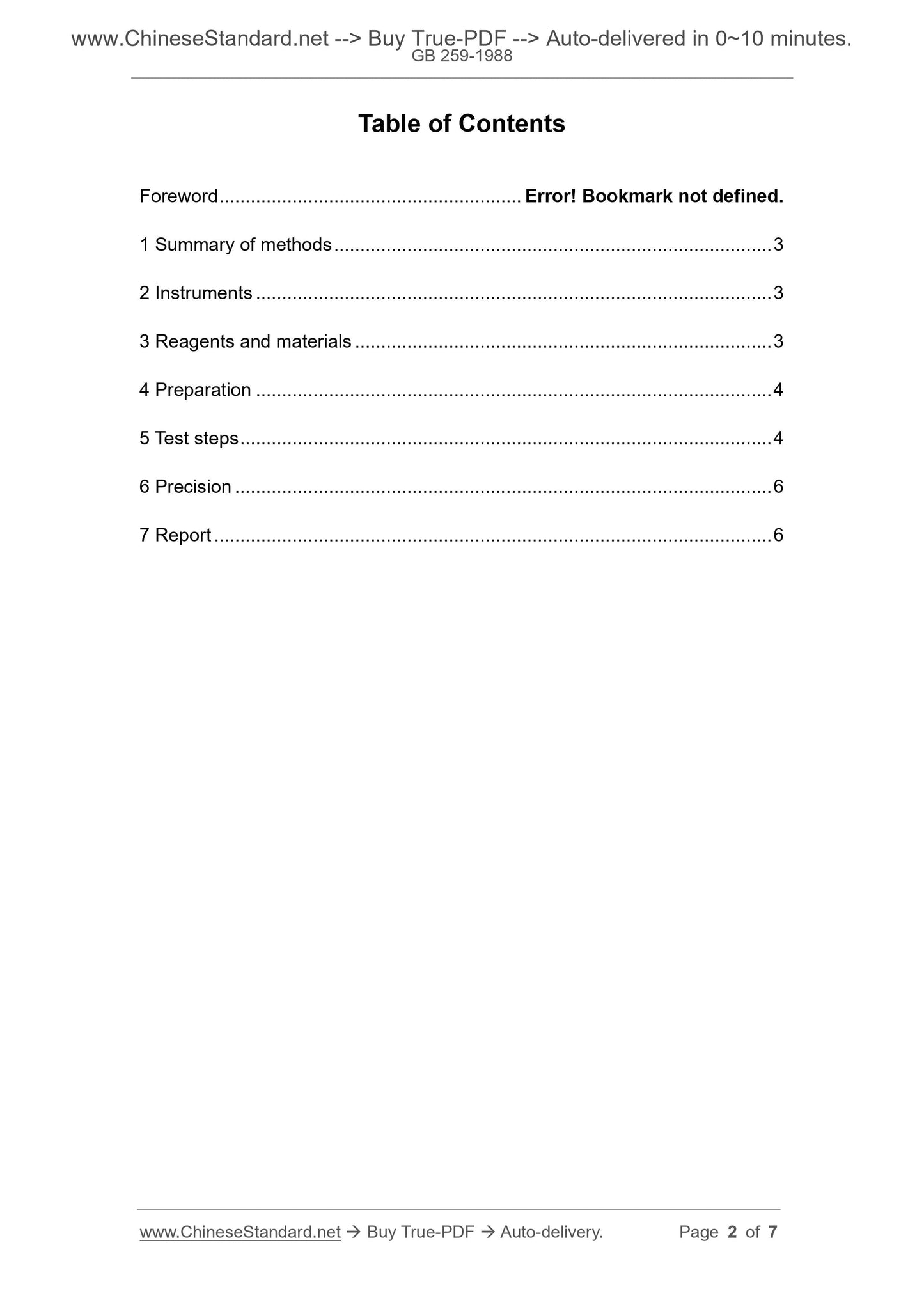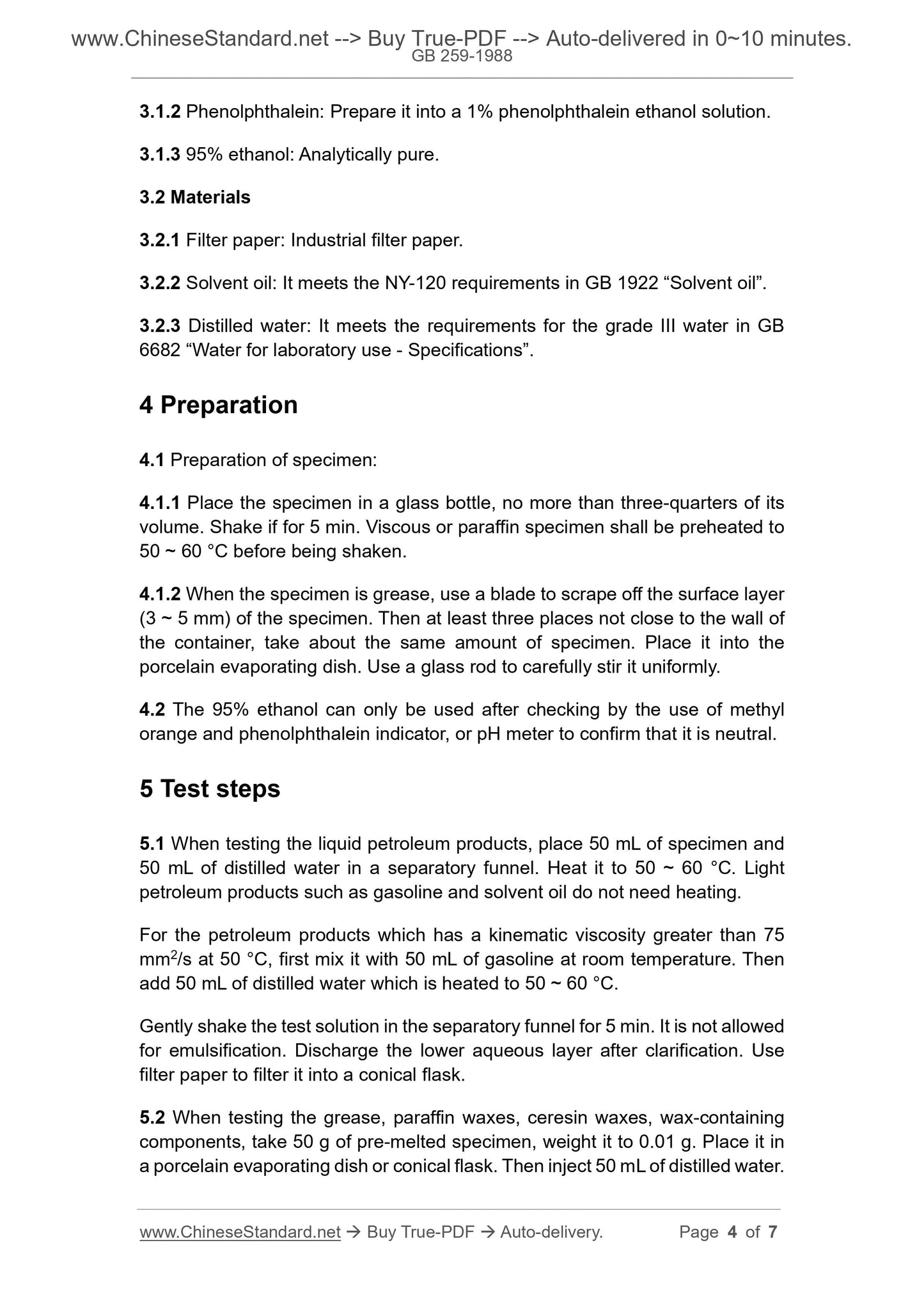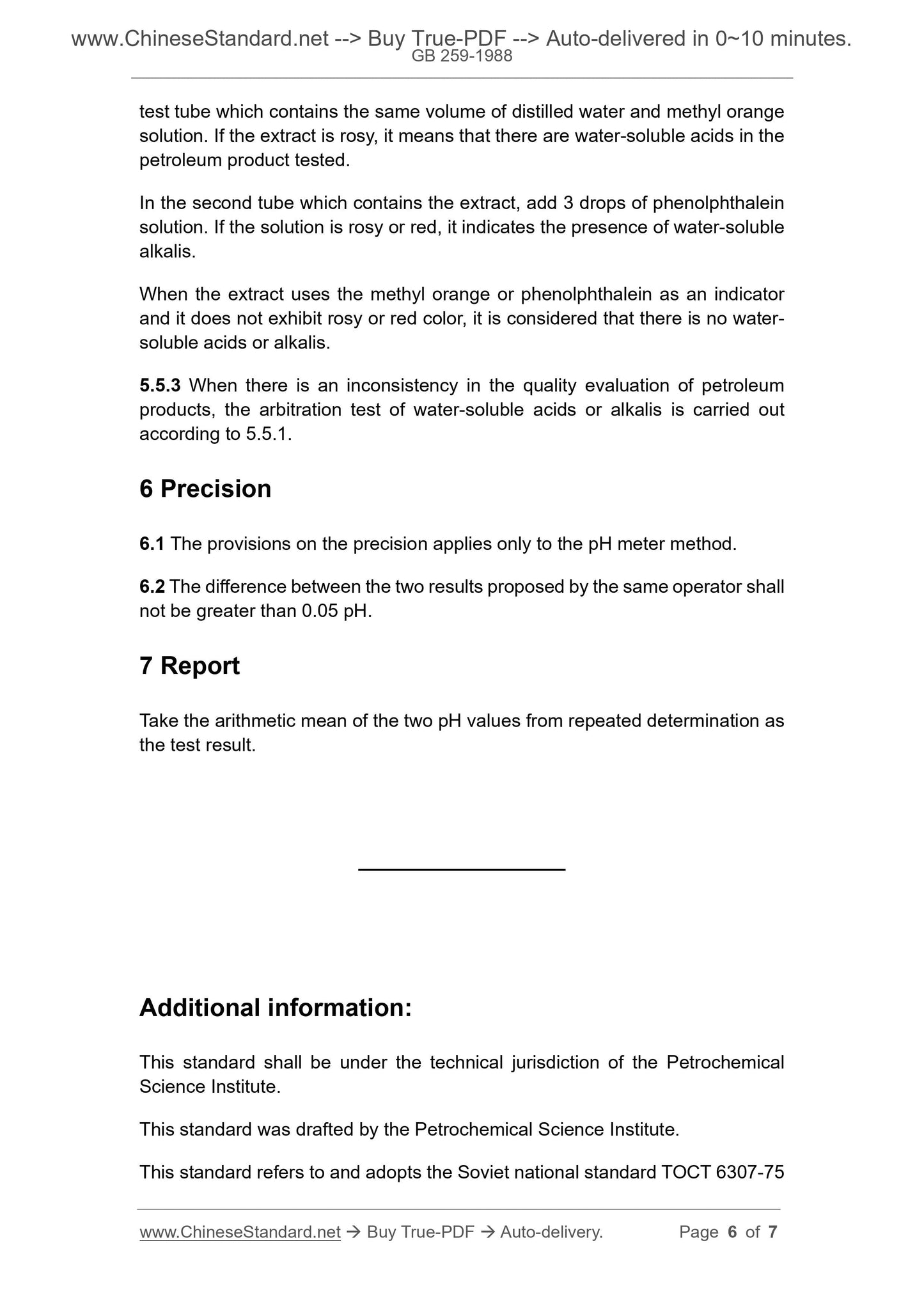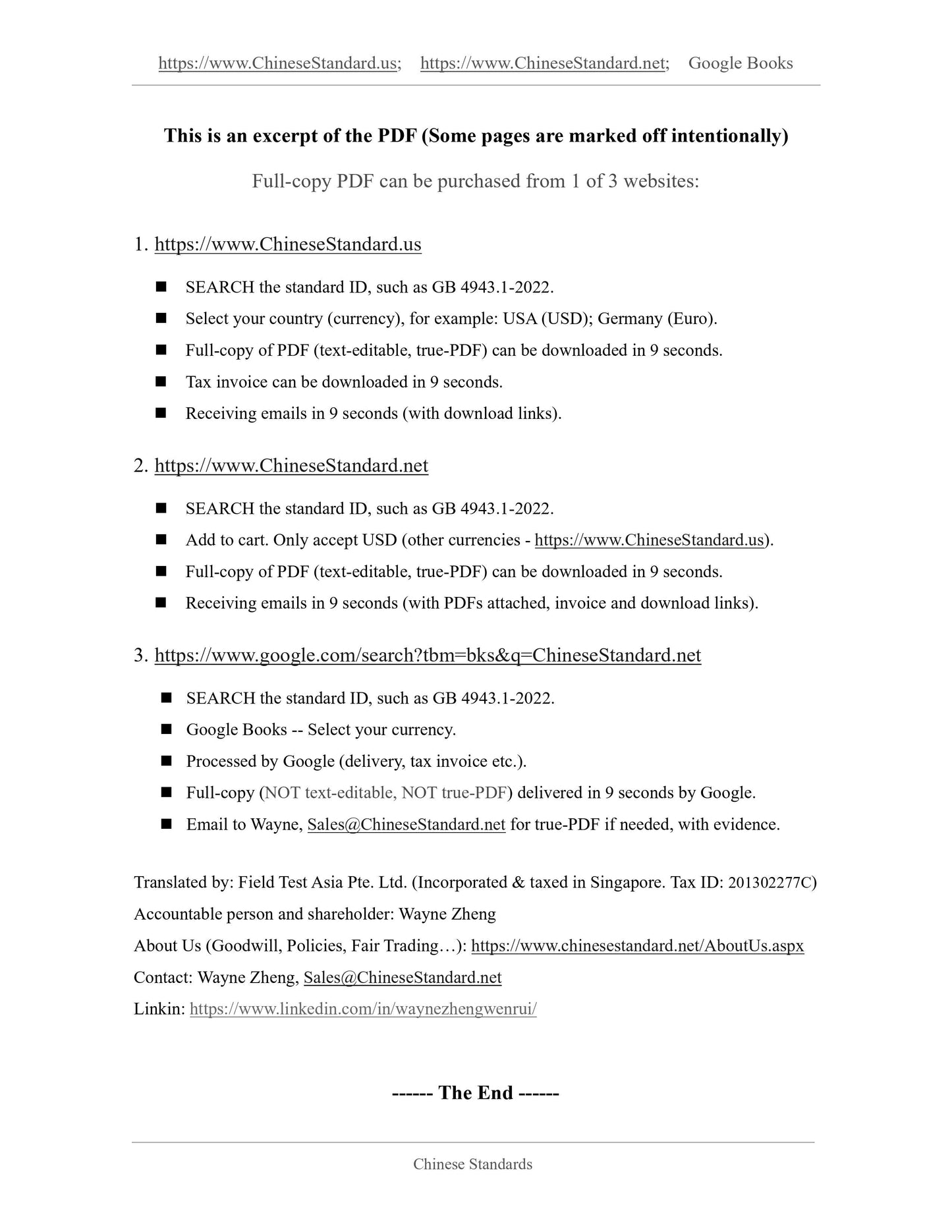1
/
of
5
PayPal, credit cards. Download editable-PDF and invoice in 1 second!
GB/T 259-1988 English PDF (GBT259-1988)
GB/T 259-1988 English PDF (GBT259-1988)
Regular price
$90.00 USD
Regular price
Sale price
$90.00 USD
Unit price
/
per
Shipping calculated at checkout.
Couldn't load pickup availability
Delivery: 3 seconds. Download true-PDF + Invoice.
Get QUOTATION in 1-minute: Click GB/T 259-1988
Historical versions: GB/T 259-1988
Preview True-PDF (Reload/Scroll if blank)
GB/T 259-1988: [Renamed from GB 259-1988] Petroleum products. Determination of water-soluble acids and alkalis
GB 259-1988
GB
NATIONAL STANDARD OF THE
PEOPLE’S REPUBLIC OF CHINA
UDC 665.52
.543.06
Replacing GB 259-1977
Petroleum products -
Determination of water-soluble acids and alkalis
ISSUED ON. MARCH 14, 1988
IMPLEMENTED ON. MARCH 01, 1989
Issued by. China Petrochemical Corporation
Table of Contents
Foreword ... Error! Bookmark not defined.
1 Summary of methods ... 3
2 Instruments ... 3
3 Reagents and materials ... 3
4 Preparation ... 4
5 Test steps ... 4
6 Precision ... 6
7 Report ... 6
3.1.2 Phenolphthalein. Prepare it into a 1% phenolphthalein ethanol solution.
3.1.3 95% ethanol. Analytically pure.
3.2 Materials
3.2.1 Filter paper. Industrial filter paper.
3.2.2 Solvent oil. It meets the NY-120 requirements in GB 1922 “Solvent oil”.
3.2.3 Distilled water. It meets the requirements for the grade III water in GB
6682 “Water for laboratory use - Specifications”.
4 Preparation
4.1 Preparation of specimen.
4.1.1 Place the specimen in a glass bottle, no more than three-quarters of its
volume. Shake if for 5 min. Viscous or paraffin specimen shall be preheated to
50 ~ 60 °C before being shaken.
4.1.2 When the specimen is grease, use a blade to scrape off the surface layer
(3 ~ 5 mm) of the specimen. Then at least three places not close to the wall of
the container, take about the same amount of specimen. Place it into the
porcelain evaporating dish. Use a glass rod to carefully stir it uniformly.
4.2 The 95% ethanol can only be used after checking by the use of methyl
orange and phenolphthalein indicator, or pH meter to confirm that it is neutral.
5 Test steps
5.1 When testing the liquid petroleum products, place 50 mL of specimen and
50 mL of distilled water in a separatory funnel. Heat it to 50 ~ 60 °C. Light
petroleum products such as gasoline and solvent oil do not need heating.
For the petroleum products which has a kinematic viscosity greater than 75
mm2/s at 50 °C, first mix it with 50 mL of gasoline at room temperature. Then
add 50 mL of distilled water which is heated to 50 ~ 60 °C.
Gently shake the test solution in the separatory funnel for 5 min. It is not allowed
for emulsification. Discharge the lower aqueous layer after clarification. Use
filter paper to filter it into a conical flask.
5.2 When testing the grease, paraffin waxes, ceresin waxes, wax-containing
components, take 50 g of pre-melted specimen, weight it to 0.01 g. Place it in
a porcelain evaporating dish or conical flask. Then inject 50 mL of distilled water.
test tube which contains the same volume of distilled water and methyl orange
solution. If the extract is rosy, it means that there are water-soluble acids in the
petroleum product tested.
In the second tube which contains the extract, add 3 drops of phenolphthalein
solution. If the solution is rosy or red, it indicates the presence of water-soluble
alkalis.
When the extract uses the methyl orange or phenolphthalein as an indicator
and it does not exhibit rosy or red color, it is considered that there is no water-
soluble acids or alkalis.
5.5.3 When there is an inconsistency in the quality evaluation of petroleum
products, the arbitration test of water-soluble acids or alkalis is carried out
according to 5.5.1.
6 Precision
6.1 The provisions on the precision applies only to the pH meter method.
6.2 The difference between the two results proposed by the same operator shall
not be greater than 0.05 pH.
7 Report
Take the arithmetic mean of the two pH values from repeated determination as
the test result.
Additional information.
This standard shall be under the technical jurisdiction of the Petrochemical
Science Institute.
This standard was drafted by the Petrochemical Science Institute.
This standard refers to and adopts the Soviet national standard TOCT 6307-75
Get QUOTATION in 1-minute: Click GB/T 259-1988
Historical versions: GB/T 259-1988
Preview True-PDF (Reload/Scroll if blank)
GB/T 259-1988: [Renamed from GB 259-1988] Petroleum products. Determination of water-soluble acids and alkalis
GB 259-1988
GB
NATIONAL STANDARD OF THE
PEOPLE’S REPUBLIC OF CHINA
UDC 665.52
.543.06
Replacing GB 259-1977
Petroleum products -
Determination of water-soluble acids and alkalis
ISSUED ON. MARCH 14, 1988
IMPLEMENTED ON. MARCH 01, 1989
Issued by. China Petrochemical Corporation
Table of Contents
Foreword ... Error! Bookmark not defined.
1 Summary of methods ... 3
2 Instruments ... 3
3 Reagents and materials ... 3
4 Preparation ... 4
5 Test steps ... 4
6 Precision ... 6
7 Report ... 6
3.1.2 Phenolphthalein. Prepare it into a 1% phenolphthalein ethanol solution.
3.1.3 95% ethanol. Analytically pure.
3.2 Materials
3.2.1 Filter paper. Industrial filter paper.
3.2.2 Solvent oil. It meets the NY-120 requirements in GB 1922 “Solvent oil”.
3.2.3 Distilled water. It meets the requirements for the grade III water in GB
6682 “Water for laboratory use - Specifications”.
4 Preparation
4.1 Preparation of specimen.
4.1.1 Place the specimen in a glass bottle, no more than three-quarters of its
volume. Shake if for 5 min. Viscous or paraffin specimen shall be preheated to
50 ~ 60 °C before being shaken.
4.1.2 When the specimen is grease, use a blade to scrape off the surface layer
(3 ~ 5 mm) of the specimen. Then at least three places not close to the wall of
the container, take about the same amount of specimen. Place it into the
porcelain evaporating dish. Use a glass rod to carefully stir it uniformly.
4.2 The 95% ethanol can only be used after checking by the use of methyl
orange and phenolphthalein indicator, or pH meter to confirm that it is neutral.
5 Test steps
5.1 When testing the liquid petroleum products, place 50 mL of specimen and
50 mL of distilled water in a separatory funnel. Heat it to 50 ~ 60 °C. Light
petroleum products such as gasoline and solvent oil do not need heating.
For the petroleum products which has a kinematic viscosity greater than 75
mm2/s at 50 °C, first mix it with 50 mL of gasoline at room temperature. Then
add 50 mL of distilled water which is heated to 50 ~ 60 °C.
Gently shake the test solution in the separatory funnel for 5 min. It is not allowed
for emulsification. Discharge the lower aqueous layer after clarification. Use
filter paper to filter it into a conical flask.
5.2 When testing the grease, paraffin waxes, ceresin waxes, wax-containing
components, take 50 g of pre-melted specimen, weight it to 0.01 g. Place it in
a porcelain evaporating dish or conical flask. Then inject 50 mL of distilled water.
test tube which contains the same volume of distilled water and methyl orange
solution. If the extract is rosy, it means that there are water-soluble acids in the
petroleum product tested.
In the second tube which contains the extract, add 3 drops of phenolphthalein
solution. If the solution is rosy or red, it indicates the presence of water-soluble
alkalis.
When the extract uses the methyl orange or phenolphthalein as an indicator
and it does not exhibit rosy or red color, it is considered that there is no water-
soluble acids or alkalis.
5.5.3 When there is an inconsistency in the quality evaluation of petroleum
products, the arbitration test of water-soluble acids or alkalis is carried out
according to 5.5.1.
6 Precision
6.1 The provisions on the precision applies only to the pH meter method.
6.2 The difference between the two results proposed by the same operator shall
not be greater than 0.05 pH.
7 Report
Take the arithmetic mean of the two pH values from repeated determination as
the test result.
Additional information.
This standard shall be under the technical jurisdiction of the Petrochemical
Science Institute.
This standard was drafted by the Petrochemical Science Institute.
This standard refers to and adopts the Soviet national standard TOCT 6307-75
Share
